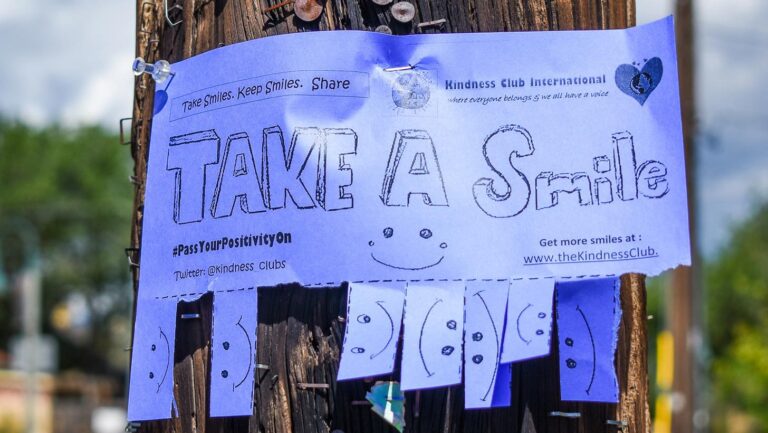You will find New Mexico schools on all the bad lists—student dropouts, teacher retention, poverty, teen pregnancy—big problems with woefully little available to make big changes. But what about small changes? Could it be that all it takes is a positive mental attitude? Melinda Forward spent 27 years in the classroom. She saw that just the acknowledgement that stress exists in students’ and teachers’ lives was a relief, so she started hosting a stress-less lunch. Lunch turned into craft time, where students started to make things to share with other students. Forward encouraged students to support each other with random tokens of kindness. Paper, scissors and glitter turned into a basket of hearts sitting on a chair at the end of the hallway. The sign said to take one and to share one. Forward says they weren’t all over the hallway floors as you would expect. Years later, Forward says many students still know where their hearts are. It was seeing the impact that such small, positive, overt acts had on a school day that prompted Forward to begin the Kindness Club to find a way to add kindness to the school day. Art has been the medium, from posters to murals to chalkboard affirmations. In the schools where it has taken hold, it seems to be working. As tough as the gauntlet of growing up in Albuquerque can be, maybe a well-placed kind word is one of the only things that does.Downtown Albuquerque gallery OT Circus is hosting a community event for the Kindness Club this Saturday to raise awareness and funds. Weekly Alibi sat down with Melinda Forward to talk about empathy and the role of small, positive things. The following is an edited version of that interview. Weekly Alibi: The first question is not how do you teach empathy, but why do you teach empathy?Melinda Forward: Schools are tough places and life’s a tough place. I think a lot of conflicts happen in schools when people don’t take time to think about how people are thinking or feeling. Everyone is a lot more alike than they realize. Why is New Mexico the number one state for student dropout?A lot of students don’t think they are ever going to graduate. They don’t have models of people that graduated. When they get stuck in struggles and conflicts they just give up. They have models for dropping out, but not for staying in?Exactly. They don’t believe in themselves or that they are ever really going to do anything, so why bother? Trauma and families, where kids end up sleeping on sofas when they’re freshmen. The poverty is a biggie.I’ve always seen Albuquerque as having some of the kindest people. Is empathy part of our culture?The culture here is all about family. It’s all about taking care of one another. Some of the machismo and all of that is about sticking up for yourself. Sticking up for your family. There is a lot of caring that goes into that attitude. In a lot of cases it is about taking care of one another. I see that in the classroom, too.So maybe it’s not empathy, it’s positivity? That’s where we go. What I find is that creating a positive environment is really vital in schools. I’ve worked in schools that are old, that are rundown, that have graffiti. The kids say we are a ghetto school. They have no pride whatsoever in their school, but a lot of it is about how it looks. The physical environment of it. There is paint chipping over there, but if you put a positive poster over that paint chip, it makes a difference. That’s what we started doing. Simple, practical steps?The smallest things made the biggest difference. One of them is the Take a Smile poster. We created these posters to go all around school. All of my students did it. With me, it’s a matter of inclusion. Nobody is left out. Everybody participates. Everybody has that opportunity, even if they think they are too cool. If everybody’s doing it, the cool kids don’t opt in, they’re just it. All of a sudden everybody is creating something. Are they taking posters and putting them over chipped areas of the school?Exactly. They put them in the bathrooms and they put them outside. The kids would pick their places. There was one that was on the door I would go in. It was like, “Everything’s possible or never give up or this is a great day.” Every time I saw that, it made me feel good, which was every time I walked in my building. It’s that spark of positivity, in a world where kids are really traumatized, where teachers are traumatized because they are working with traumatized kids, that positivity and reaching out, even indirectly. Having a message to share, putting that on paper, making it all pretty with your art and putting it up somewhere of your choice. For the students, that was really powerful.What is the role of the arts in your process?It is giving students a chance in simple ways to express themselves, to create something they can share with others and that they think will make a difference. That’s it. There is the smile poster, like you’d have phone numbers for an apartment, it has smiles all along the bottom. A student created it, it’s super simple and we just plaster them around school. People take all the little smiles. We are coming up on the end of the school year. What is the best gift to get a teacher who has had a positive influence on your child’s life?A thank you note. Really. No phone calls. No emails. A handwritten thank you note explaining why.
Kindness Club Community Art FestivalSaturday, May 18, Noon to 4pmOT Circus709 Central Ave. NWFree










